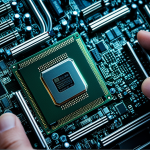Core security features in UK computing hardware
UK computing hardware integrates hardware-based security to ensure data protection and system integrity. Central to this approach is secure boot, a process that verifies the authenticity of firmware and software during startup. It prevents unauthorized code from running by validating digital signatures, which protects devices from rootkits and bootkits.
Encrypted storage at the hardware level is another crucial feature. By encrypting data directly within the device, it safeguards sensitive information even if storage media is removed or stolen. This encryption often works alongside trusted platform modules (TPMs)—dedicated chips that manage cryptographic keys and provide hardware-based authentication.
In the same genre : How does UK computing hardware support advancements in augmented reality?
Hardware-based authentication enhances security by using physical components to verify user identity or device integrity, reducing reliance on software-only methods prone to hacking. TPMs enable secure key storage and generation, reinforcing trust in the system’s hardware root of trust.
Together, these core security features form the foundation of robust UK cybersecurity solutions, ensuring devices can resist sophisticated attacks from firmware to user data protection layers. This layered defense is vital for public sector and critical infrastructure environments.
Topic to read : How Does Computing Hardware Influence UK Business Productivity?
Core security features in UK computing hardware
UK computing hardware increasingly integrates robust hardware-based security measures vital to safeguarding sensitive data. Central to this are secure boot processes, which verify the authenticity of firmware and software during startup. This mechanism prevents unauthorized code from executing, enhancing device integrity from the moment power is applied.
Encrypted storage at the hardware level is another cornerstone, ensuring that data remains protected even if physical drives are compromised. This encryption is typically managed by dedicated chips, reducing risks associated with software-only solutions.
Additionally, UK cybersecurity solutions have widely adopted hardware-based authentication methods. Trusted Platform Modules (TPMs) embedded in UK computing hardware provide a secure environment for cryptographic operations, such as key generation and storage. TPMs serve as a hardware root of trust, enabling features like device attestation and secure identity verification.
Implementing these integrated security components creates resilient defense layers critical for meeting stringent security expectations in the UK’s digital landscape. Collectively, secure boot, hardware encryption, and TPMs drive trustworthiness in the computing hardware foundational to national cybersecurity strategies.
Regulatory standards and government guidelines shaping hardware security
Government oversight plays a crucial role in securing UK computing hardware. The National Cyber Security Centre (NCSC) guidelines establish expectations for hardware-based security, setting a baseline for manufacturers and users. These guidelines emphasize stringent hardware regulation to ensure devices resist tampering and maintain integrity.
UK government cybersecurity policies mandate compliance with these standards, influencing hardware architecture design. Compliance requires device manufacturers to implement measures like secure boot and hardware-encrypted storage to align with national security priorities. This creates measurable benchmarks that help evaluate security effectiveness.
Meeting these compliance requirements impacts industry adoption by driving the integration of trusted components such as trusted platform modules (TPMs). These modules support hardware authentication in line with government frameworks, reinforcing trust in hardware authenticity.
Consequently, UK organizations sourcing computing hardware must consider NCSC recommendations and government regulation to avoid vulnerabilities. This regulatory environment fosters a landscape where hardware-based security is not optional but fundamental, forming a foundation for reliable UK cybersecurity solutions.
Core security features in UK computing hardware
UK computing hardware prioritizes hardware-based security to protect critical systems and data. One key feature is secure boot, which confirms the legitimacy of firmware and software each time a device powers on. This process uses cryptographic signatures to prevent unauthorized or malicious code from loading, ensuring the device starts in a known and trusted state.
Encrypted storage integrated at the hardware level offers strong data protection. By encrypting data directly on storage drives, it maintains confidentiality even if physical components are removed or accessed illicitly. This method significantly raises the difficulty for attackers seeking to extract sensitive information.
Hardware-based authentication plays a vital role, especially with the inclusion of Trusted Platform Modules (TPMs). TPMs securely generate, store, and manage cryptographic keys, acting as the hardware root of trust. They support vital security functions like device attestation and identity verification, which are foundational in UK cybersecurity solutions.
Together, these elements—secure boot, encrypted storage, and TPMs—form a cohesive defense. UK computing hardware’s integration of these technologies delivers robust protection tailored to meet the country’s stringent cybersecurity demands.
Core security features in UK computing hardware
UK computing hardware incorporates advanced hardware-based security features essential for protecting data and system integrity. A pivotal element is secure boot, which validates firmware and software authenticity during startup. This ensures only trusted code executes, preventing malware infiltration at the earliest stage.
Hardware also employs encrypted storage techniques, safeguarding data directly within physical drives. This encryption, implemented at the hardware level, provides continuous protection, even if storage devices are physically compromised or removed.
Additionally, hardware-based authentication methods are widely used, particularly through trusted platform modules (TPMs). TPMs securely generate, store cryptographic keys, and enable device attestation, anchoring trust in the hardware itself. This foundational hardware root of trust supports identity verification and strengthens overall system security.
Together, these features—secure boot, encrypted storage, and TPMs—form a cohesive, multilayered defense framework. They are integral components in modern UK cybersecurity solutions, ensuring devices meet stringent protection standards against increasingly sophisticated cyber threats, particularly in critical sectors where hardware resilience is a national security priority.
Core security features in UK computing hardware
UK computing hardware employs a multi-layered approach to hardware-based security, focusing on essential features that underpin device trustworthiness. A pivotal element is secure boot, which authenticates firmware and software during device startup. This process uses embedded cryptographic checks to confirm that only authorized code runs, effectively blocking malware from early execution.
At the storage layer, hardware-level encryption protects data confidentiality directly on devices. This approach secures information even if physical drives are extracted, ensuring data remains inaccessible without proper cryptographic keys.
The deployment of hardware-based authentication is increasingly prevalent, often enabled by Trusted Platform Modules (TPMs). TPMs generate and securely manage cryptographic keys within isolated hardware boundaries. These modules support secure identity verification, device attestation, and form the hardware root of trust—cornerstones of UK cybersecurity solutions.
Together, these features—secure boot, hardware encryption, and TPM-backed authentication—provide a robust defense framework. This integration is critical for addressing evolving cyber threats and fulfilling strict security requirements mandated across UK sectors.
Core security features in UK computing hardware
UK computing hardware integrates multiple hardware-based security features to protect devices from unauthorized access and tampering. One essential feature is secure boot, which verifies firmware and software authenticity at startup. This process uses cryptographic signatures to ensure only trusted code executes, preventing malware infiltration from the earliest phase of device operation.
Encrypted storage at the hardware level is another fundamental component. By encrypting data directly on physical drives, it protects sensitive information even if the hardware is physically compromised or removed. This ensures confidentiality and mitigates risks from theft or loss.
Furthermore, UK computing hardware widely adopts hardware-based authentication methods, particularly through Trusted Platform Modules (TPMs). TPMs securely generate and store cryptographic keys within specialized chips, creating a hardware root of trust. They support critical functions like device attestation and identity verification, which enhances overall system security.
Together, these elements—secure boot, encrypted storage, and TPM-backed authentication—form the foundation of UK cybersecurity solutions. Their integration offers robust protection adapted for the stringent security needs of UK computing environments.
Core security features in UK computing hardware
UK computing hardware integrates multiple hardware-based security measures vital for safeguarding data and device integrity. A fundamental feature is secure boot, which ensures every startup phase authenticates firmware and software digitally. This verification prevents malware from executing during the initial power-up, fostering a trusted system state from the outset.
Encrypted storage at the hardware level complements this by securing data directly on storage modules. This encryption shields information even if physical drives are removed or accessed illicitly, enhancing confidentiality beyond software protections. By embedding encryption controls within the hardware, threats targeting storage media face significant barriers.
In addition, hardware-based authentication using trusted platform modules (TPMs) forms another critical pillar of UK cybersecurity solutions. TPMs securely generate and store cryptographic keys integral to identity verification and system attestation. Acting as a hardware root of trust, TPMs underpin secure key management and reinforce system-wide integrity.
Together, these core security features—secure boot, encrypted storage, and TPM-backed authentication—form a layered defence intrinsic to the UK’s computing environments. They collectively strengthen hardware resilience against increasingly sophisticated cyber threats and align with national cybersecurity objectives.










